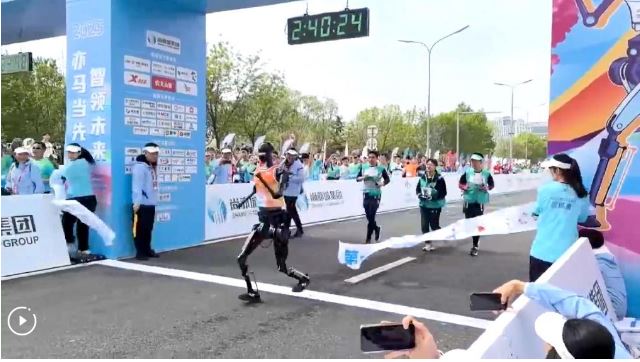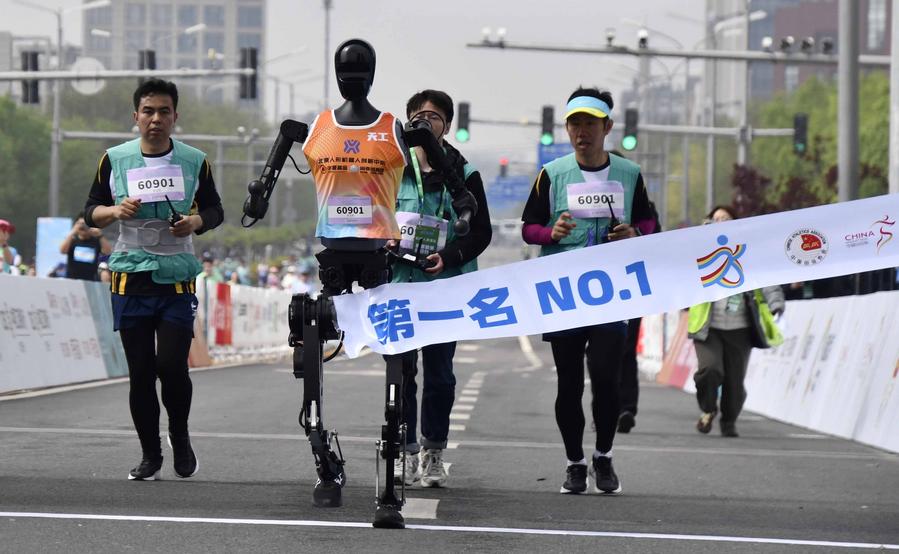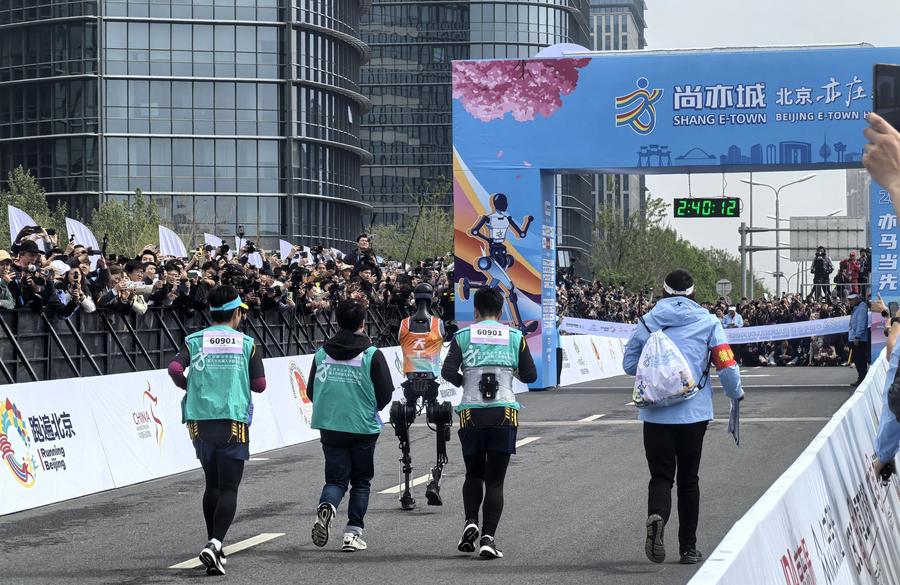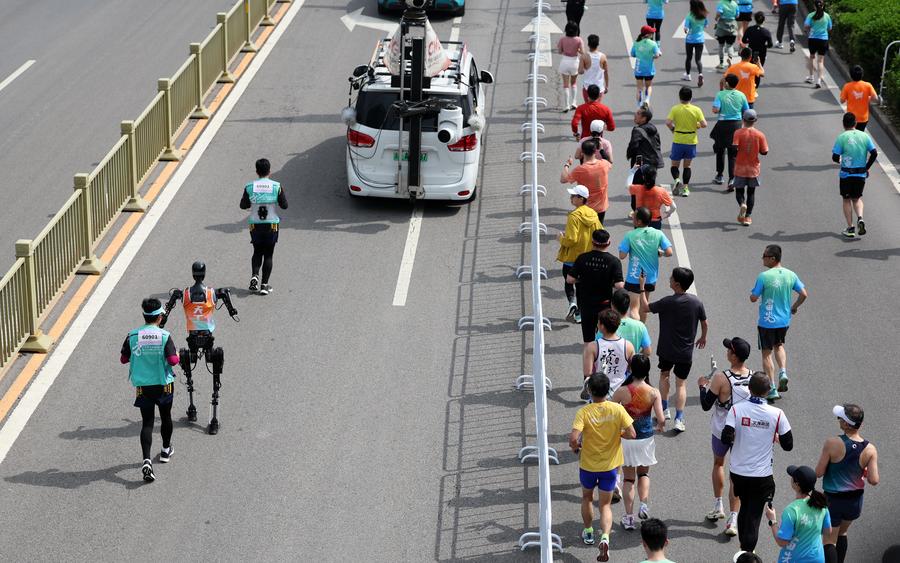

A new technological milestone was reached Saturday in the Beijing Economic-Technological Development Area as humanoid robots completed a half-marathon for the first time globally.
The robots followed the same route as human runners but on separate tracks.
Tiangong Ultra, developed by the Beijing Humanoid Robot Innovation Center, clocked two hours, 40 minutes, and 42 seconds, winning this historic 21.0975-kilometer race among 20 competing teams.
"Tiangong Ultra crossed the finish line about 30 minutes earlier than expected," said the Centre's CEO Xiong Youjun.
"All the robots today performed great basically, in dealing with challenges such as turns and speed bumps. We made history together."

Originally scheduled for April 13, the humanoid robot half-marathon was postponed to Saturday due to a high wind alert in the city last weekend, providing teams with more time to test and refine the structure and control system of the robot runners.
"During a 21km trial, a screw connecting the ankle motor and linkage snapped at the 15km mark. We reinforced the part with three positioning pins -- no issues since," recalled Cui Wenhao, leader of the Xuanfeng Xiaozi Team.
Given that the humanoid robots on the track differ in height and weight, they are intended for future deployment in designated fields, including manufacturing, healthcare, and education.
Zhao Fuming, director of the Beijing Marathon Association, noted, "Robots highlighted the race indeed. More cities may learn from such experience to integrate new concepts into marathon. However, robots may not necessarily participate as runners. They can also give a hand in security checking or other operation tasks."
Meanwhile, in the human race held on Saturday, Ethiopian runners won both the men's and women's half-marathons
HISTORY
In a historic fusion of athletic tradition and cutting-edge technology, humanoid robots and human runners took to the same half marathon course in Beijing on Saturday - marking the world's first event of its kind.
Covering 21.0975 kilometers through the capital's Economic-Technological Development Area, the race redefined what it means to compete, innovate, and imagine the future of embodied intelligence.
Industry insiders highlighted the half marathon's balance of challenge and accessibility as it tested endurance while welcoming diverse participants.
HOW THEY DID IT
The event saw humanoid robots line up alongside human athletes, launching from the same starting line but along physically divided lanes to ensure safety. While human runners followed conventional rules, robots competed under tailored guidelines.
Each robot was supported by a team of human navigators, operators, and engineers. Robots launched sequentially at intervals exceeding one meter, confined to dedicated tracks where battery swaps mirror Formula 1's pit stops.
Awards were distributed not just for speed, but for categories like Best Endurance, Best Gait Design, and Most Innovative Form - celebrating both athletic performance and engineering ability.
Among 20 competing teams, Tiangong Ultra from the Tiangong Team claimed victory in the humanoid half marathon, crossing the finish line first with a time of two hours, 40 minutes, and 42 seconds.
 Robotic participant "Tiangong Ultra" (3rd L) competes as engineers run alongside during the race. (Xinhua/Ju Huanzong)
Robotic participant "Tiangong Ultra" (3rd L) competes as engineers run alongside during the race. (Xinhua/Ju Huanzong)
Standing approximately 1.8 meters tall and weighing 55 kilograms, Tiangong Ultra increased its speed from 6 km/h to a peak of 12 km/h and enhanced its intelligence this year using the Huisi Kaiwu platform, a universal embodied intelligence system. During the race, Tiangong Ultra maintained a steady pace of 7-8 km/h.
"I saw many robots running along the course. Some compact robots were surprisingly fast, it is beyond my imagination," said Zhang Huihui, who competed alongside robots. "I hope to see robots every year at marathon events, watching them run faster and faster."
Yet beneath the novelty lay a formidable challenge. Robots had to navigate a demanding course that weaved through Nanhaizi Park, Paulownia Boulevard and Wenbo Bridge and confronted a gauntlet of terrains: cracked asphalt, gravel-strewn paths, undulating slopes, and grassy patches.
Each surface demanded split-second adjustments in stride length, body posture, and power distribution, pushing locomotion algorithms to their limits.
"These robots are as diverse as their creators," noted Liang Liang, Deputy Director of Yizhuang's Administrative Committee.
"Some prioritize speed, others charm with expressive interactions or sleek designs. While all rely on electric propulsion, their starting mechanisms and running styles vary wildly - a testament to the creativity driving this field."
A NEW HORIZON: FROM TRACK TO DAILY LIFE
More than a race, this event served as a symbolic launchpad for China's burgeoning humanoid robotics industry.
In 2024, China's Ministry of Industry and Information Technology issued the Implementation Opinions on Promoting Innovation and Development of Future Industries, identifying fields such as smart manufacturing, household services, and operations in extreme environments as priority areas for humanoid robot deployment.

Data from China's Ministry of Industry and Information Technology reveals that as of July 2024, China holds over 190,000 valid patents related to robotics, accounting for approximately two-thirds of the global total.
Xu Xiaolan, President of the China Electronics Society, emphasized that emerging technologies like AI are in a phase of explosive innovation, with AI's role in empowering robotics growing increasingly prominent.
The Embodied Intelligence Development Report (2024) posits that embodied intelligence will unlock vast application potential across multiple fields, marking a critical step toward achieving general AI.
The China Electronics Society forecasts that China's humanoid robot market could reach approximately 870 billion yuan (about 119 billion U.S. dollars) by 2030.
"Robots completing the race isn't the finish line. It's the starting point for industrial growth and cross-disciplinary learning," said Liang. "Their small steps today will become giant leaps for human technological progress tomorrow."













